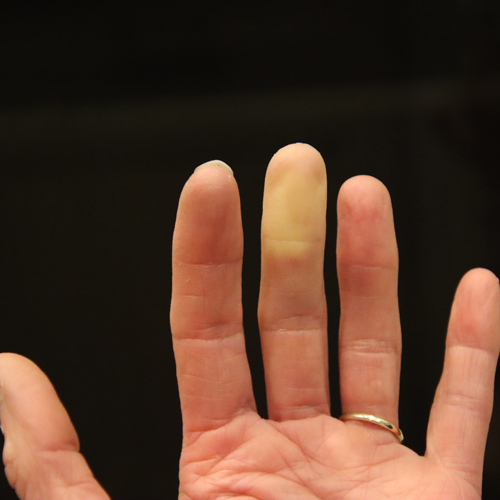
Improving Your Quality of Life When Diagnosed With Lupus
Author: be well™ with Big Y® Registered Dietitian Team
To bring attention to the more than estimated 1.5 million Americans diagnosed with lupus, May is designated as Lupus Awareness Month.
Impacting predominantly women between the ages of 15-44 years old, men and children can also be diagnosed with lupus. The Lupus Foundation of America cites the condition is two to three times more prevalent among African American, Hispanic/Latina, Asian American, Native American, Alaska Native, Native Hawaiian and other Pacific Islander women than White women.
Learn more about this autoimmune disease, its symptoms and recommended lifestyle behaviors so you may live your best life and thrive after diagnosis.
What is Lupus?2,3

An autoimmune disease, lupus occurs when your body’s immune system reacts to its own tissues, such as skin, muscles and organs, as if they are outside invaders, like bacteria and viruses, and attacks them. This immune system reaction causes the body to be in a state of inflammation, that can manifest into symptoms such as extreme fatigue, painful joints, irritated skin and hair loss.
Types of Lupus
Lupus can present in a multiple of ways, though, the type impacting the entire body, systemic lupus erythematosus, is the most prominent.

Systemic Lupus Erythematosus
The majority of individual diagnosed with lupus are diagnosed with systemic lupus. Symptoms of systemic lupus includes swollen, painful and sore joints and feet, fatigue, skin rash and possible detrimental, long-term impact on the kidneys, heart, lungs, nervous system, bones and blood.

Cutaneous Lupus
In conjunction with systemic lupus, many individuals will develop cutaneous lupus that impacts the skin. Cutaneous lupus can show in different ways, but typically large rashes will develop on areas of the skin in contact with sunlight, like the face, scalp and arms. Mucosal lesions may also develop in the mouth, nose and vagina. Hair loss can occur due to sores and rashes on the scalp or as a side effect of prescribed medication to treat symptoms.

Drug-Induced Lupus
Some medications prescribed to treat conditions like high blood pressure, irregular heartbeat and tuberculosis can cause symptoms similar to lupus. When this occurs, it is diagnosed as drug-induced lupus.

Neonatal Lupus
Infants born to mothers with lupus can sometimes develop symptoms similar to lupus. Symptoms like skin rash and liver issues will typically resolve over the course of baby’s first year.
Treating Lupus

A multi-pronged approach is typically utilized when treating lupus. From treating symptoms and strengthening the body’s natural defenses to reducing the impact to your body’s organs and preventing painful flare ups of inflammation—medication, nutrition and lifestyle behaviors are the keys to thriving and feeling your best.
Pharmacological3

Common medications for treating lupus symptoms include over the counter nonsteroidal anti-inflammatory drugs (NSAIDs) such as ibuprofen and naproxen. Corticosteroids, antimalarial medication and immunomodulators (BLyS-specific inhibitors) may be prescribed as well. For certain cases of lupus, immunosuppressive drugs and chemotherapy may be utilized.
To help offset the impact of lupus on specific areas of the body like the heart, lungs, bones and blood, additional medications may be prescribed to address and/or prevent secondary conditions such as blood clots, pleuritis (inflammation of the sac around the lungs), osteoporosis and anemia.
Nutrition
Since lupus is an autoimmune disease triggering inflammation in the body, choosing foods that aid in reducing inflammation as the base of meals and snacks is key.

Eat more veggies
Aim for at least 2½ cups vegetables each day with a variety of options focused on dark green, red and orange veggies and beans, peas and lentils. Learn more about upping your veggie intake in our “Resolution 2023: Eat More Veggies” article.

Eat more fruits
Aim for at least 2 cups fruit each day with a variety of colors and forms like frozen, fresh, canned, dried and 100% juice. Learn more about increasing your fruit intake in our “Resolution 2023: Eat More Fruits” article.

Eat more whole grains
Make half your daily servings from the Grains Food Group whole grain. You’ll get more fiber, minerals and vitamins, like the antioxidant vitamin E, in meals while offsetting the amount of refined grains you eat. Learn more in our “Resolution 2023: Wholly Whole Grains” article.

Focus on omega-3 fats
Consider combining your seafood intake with omega-3 supplements to help with inflammation and heart health. Always speak to your healthcare provider before adding a supplement to your daily intake. To learn more, check out our “Omega-3s: Essential for Health” article.

Drink less sugar
Like foods made primarily with refined grains, sugary-drinks will not help the cascade of inflammation occurring when diagnosed with lupus. Learn our tips for reducing your intake in our “Resolution 2023: Drink Less Sugar” article.

Get 3-A-Day
Getting your “3-A-Day” servings from the Dairy Food Group is a delicious way to meet calcium needs—essential for keeping bones healthy, especially when diagnosed with lupus. Learn all the ways to meet your needs in our “Dairy: The Unsung Hero in Your Meals” article.

Eat plant-forward
When choosing plant-based foods to meet needs, such as calcium, opt for animal-free alternatives that offer the equivalent amounts of nutrients. For example, soymilk in place of cow’s milk to ensure you're meeting calcium goals. Learn more in our “Vegetarian vs. Vegan: What’s the Difference?” article.
Lifestyle Behaviors4

- If you smoke, stop. Smoking can activate symptoms in addition to putting your heart, blood vessels, bones and lungs at risk even further.
- Continue moving. Staying active, even in the face of exhaustion and painful joints, is essential to maintain strength and mobility. Work with personal trainers as well as physical and occupational therapists to learn what will help you most at home, work and while exercising. You may find low impact exercises such as walking, swimming, riding bicycles, gentle yoga and qigong extremely beneficial.
- Be realistic with your schedule. Less energy means being intentional on how you spend your time. Focus daily routines around priorities while purposely weaving in plenty of self-care breaks, rest time and naps.
- Ask for help. Between your family, friends and employer, discuss ways you can call on others for help in activities you historically took on yourself. This is the time to delegate and add in accommodations to help you meet your needs and goals.
- Soothe stress. Pair mindfulness practices such as mediation, journaling, being outdoors and breath work with cognitive behavioral therapy to best negotiate this new chapter in life. Learn more in our “Become Mindful for Your Health” article.
What Causes Lupus?5

At this time, a specific cause for lupus is unknown. Although some individuals may have another family member diagnosed with lupus, many do not. Different hormonal changes have been theorized, such as estrogen and women in their childbearing years, but research to support this hypothesis is still lacking. Intense moments of stress like giving birth, grieving the loss of a family member, experiencing a traumatic injury as well as extreme exhaustion, exposure to ultra-violet (UV) light and specific medications may serve as triggers for “turning on” lupus.
Is Lupus Curable?

Currently, lupus is considered a lifelong disease once it’s diagnosed. Instead of treating to cure, the focus is managing symptoms, reducing risk on different organs and minimizing flare ups.
If you, a family member or friend have been diagnosed with lupus, or suspect you may have lupus, visit the Lupus Foundation of America website at www.lupus.org.
1 Lupus Foundation of America. Lupus facts and statistics. https://www.lupus.org/resources/lupus-facts-and-statistics. Accessed 4/14/2023.
2 Lupus Foundation of America. What is lupus? https://www.lupus.org/resources/what-is-lupus. Accessed 4/14/2023.
3 Centers for Disease Control and Prevention. Lupus Basics. https://www.cdc.gov/lupus/basics.htm. Accessed 4/14/2023.
4 Lupus Foundation of America. Lupus information packet. https://www.lupus.org/sites/default/files/media/documents/lfa-resources-packet.pdf. Accessed 4/14/2023.
5 Lupus Foundation of America. What causes lupus? https://www.lupus.org/resources/what-causes-lupus. Accessed 4/14/2023.
Published 5/22/2023



